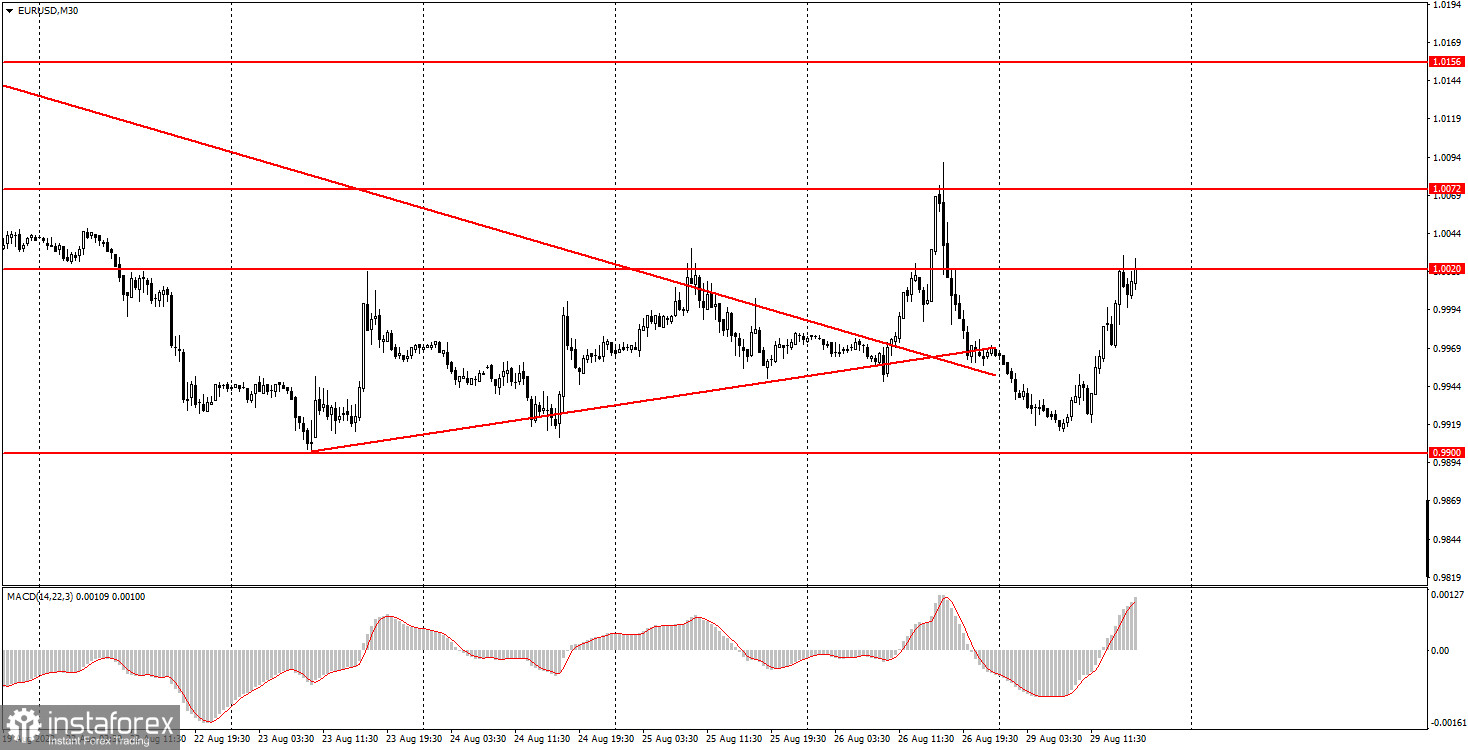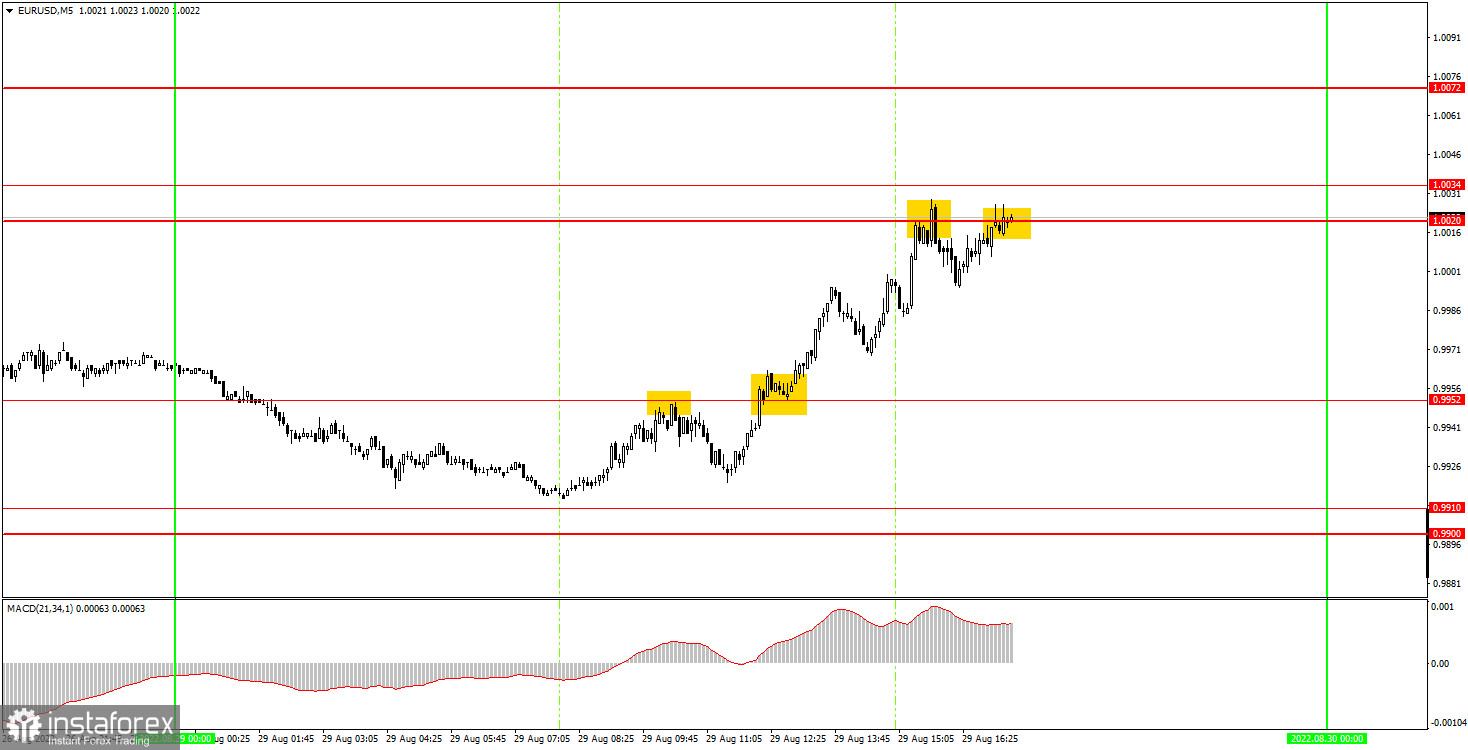Analysis of Monday's deals:
30M chart of the EUR/USD pair

The EUR/USD currency pair quite unexpectedly began a new round of upward correction on Monday. After an upward trend line has been broken, one could count on the pair to fall further, but this time it was not possible to fall to its 20-year lows, and by the end of the day the price rose to the level of 1.0020, which is the formal upper limit of the horizontal channel with a lower limit of 0.9900. If there is a rebound from 1.0020, then we will be even more confident that the pair has hit another flat. There were no important macroeconomic statistics or fundamental events either in the US or in the European Union on Monday. However, the day's volatility topped 100 points, which is nothing like a "boring Monday". As you can see, traders still find reasons to trade actively, and not sit on the fence. Plus, do not forget that the pair continues to be near its 20-year lows, which means that the fall can resume at any moment. Most of the factors still support the dollar.
5M chart of the EUR/USD pair

There were enough trading signals on the 5-minute timeframe on Monday. The very first signal could have formed at the beginning of the European trading session, but the price was only four points short of 0.9910 to rebound from it. Four points is a lot to consider a signal as an "under-rebound". Thus, it was not possible to open a long position here. This was followed by a false sell signal on a rebound from the level of 0.9952. The price, however, went down 16 points, which allowed beginners to set Stop Loss to breakeven according to our recommendations. The deal was closed by this Stop Loss. The next buy signal - overcoming the level of 0.9952 - made it possible for traders to make good money already, as the price rose to the level of 1.0020 and rebounded from it. You should have closed longs and opened shorts on this signal. Profit amounted to 45 points. The short position turned out to be less successful, but in this case the price managed to go down 15 points, so there was no loss. Even if novice traders did not have time to place Stop Loss, the pair still failed to settle above the level of 1.0020, so there was also plenty of time to get rid of this deal without losses. Therefore, the day ended with a profit of about 45 points, which is very good.
How to trade on Tuesday:
The pair has decided not to resume the downward trend on the 30-minute timeframe right now. Instead, it decided to spend some more time inside the 0.9900-1.0020 horizontal channel. Thus, before overcoming any of the channel boundaries, a flat can be observed. On the 5-minute TF on Tuesday, it is recommended to trade at the levels 0.9900-0.9910, 0.9952, 1.0020-1.0034, 1.0072, 1.0123, 1.0156. When passing 15 points in the right direction, you should set Stop Loss to breakeven. No important events or reports are scheduled again in the European Union and the United States on Tuesday. Thus, traders will again have nothing to pay attention to. The first trading day of the week showed that there are no problems with volatility and activity now, but the pair is still in a flat.
Basic rules of the trading system:
1) The signal strength is calculated by the time it took to form the signal (bounce or overcome the level). The less time it took, the stronger the signal.
2) If two or more deals were opened near a certain level based on false signals (which did not trigger Take Profit or the nearest target level), then all subsequent signals from this level should be ignored.
3) In a flat, any pair can form a lot of false signals or not form them at all. But in any case, at the first signs of a flat, it is better to stop trading.
4) Trade deals are opened in the time period between the beginning of the European session and until the middle of the US one, when all deals must be closed manually.
5) On the 30-minute TF, using signals from the MACD indicator, you can trade only if there is good volatility and a trend, which is confirmed by a trend line or a trend channel.
6) If two levels are located too close to each other (from 5 to 15 points), then they should be considered as an area of support or resistance.
On the chart:
Support and Resistance Levels are the Levels that serve as targets when buying or selling the pair. You can place Take Profit near these levels.
Red lines are the channels or trend lines that display the current trend and show in which direction it is better to trade now.
The MACD indicator (14,22,3) consists of a histogram and a signal line. When they cross, this is a signal to enter the market. It is recommended to use this indicator in combination with trend lines (channels and trend lines).
Important speeches and reports (always contained in the news calendar) can greatly influence the movement of a currency pair. Therefore, during their exit, it is recommended to trade as carefully as possible or exit the market in order to avoid a sharp price reversal against the previous movement.
Beginners on Forex should remember that not every single trade has to be profitable. The development of a clear strategy and money management are the key to success in trading over a long period of time.
 English
English 
 Русский
Русский Bahasa Indonesia
Bahasa Indonesia Bahasa Malay
Bahasa Malay ไทย
ไทย Español
Español Deutsch
Deutsch Български
Български Français
Français Tiếng Việt
Tiếng Việt 中文
中文 বাংলা
বাংলা हिन्दी
हिन्दी Čeština
Čeština Українська
Українська Română
Română

